Are You A Vanguard? Applications Now Open
This is your first of three free stories this month. Become a free or sustaining member to read unlimited articles, webinars and ebooks.
Become A MemberLas Vegas boasts a tower the size of the Empire State Building built solely for views and bungee jumping, a nightclub so lavish it cost $60 million to build, and a half-scale replica of the Eiffel Tower. But the most arresting sight you’ll ever see in the Mojave’s Valley of the Sin takes place just once about every 30 days. For a few hours, each first Friday of the month, you can witness something you’d never thought you’d see in Vegas: Real urban life.
On First Friday, the riders on the city’s public buses — usually a collection so sullen they virtually beg you to compose stories about how their lives went awry, leaving them broke and carless in Vegas — are replaced by fresh-faced adolescents from the underwater apartment complexes and gated communities strewn across the area. Converging at the downtown transit center, they wander through the streets, uncharacteristically closed to traffic and packed with pedestrians — and so teeming with tents and food trucks that you can almost miss the boarded-up buildings and desert sand lots behind them.
The people don’t come for the art, which tends toward clichéd identity markers of various subcultures: Skater-punk, Rastafarian, goth. Nor do they come for the food. Yes, the trucks turn out some fine fare, but a delicious meal in Las Vegas is never farther than your local strip mall.
What the people turn out for is each other. In Las Vegas, tourists dominate the Strip. What appears to be a massive urban crowd is actually an ersatz version of one, more like the local Eiffel Tower than the Parisian original. No one bumps into their coworkers or neighbors; no one is part of the Las Vegas community; and everyone will be hungover in the airport departure lounge in a few days, if not hours. For the locals, Las Vegas is essentially a giant suburb, segregated by income into apartment complexes that range from glorified roadside motels to five-star-caliber condos and gated communities marked with banners explicitly stating how many hundreds of thousands of dollars you need to be welcomed. The city is also segregated by age to a greater extent than any American city since its main gathering spaces, casinos, are closed to those under 21. And for those too young or too poor to drive, most of the urban fabric of the city itself is inaccessible. First Friday is one of the only public, community-run institutions in a region of nearly two million people.
Or at least it was. Last September, a group of executives from Zappos, the online shoe store based in the well-to-do suburb of Henderson, Nev., bought First Friday. But how can anyone own First Friday, the most prominent expression of public life in Las Vegas? Well, running the monthly festival costs money for things like police overtime and portable toilets, and Whirlygig, the non-profit that founded First Friday, had fallen into debt. For roughly half a million dollars, the “Zapponians,” as they call themselves, bought the rights to the “First Friday” name, assumed the debt and pledged further spending to expand the event. Already, First Friday has grown physically, closing off more streets than before and attracting larger crowds. March’s event, which featured a mini-Burning Man-style effigy incineration, attracted 25,000 people, according to Las Vegas Mayor Carolyn Goodman.
The prime mover behind the purchase was Zappos CEO, corporate culture guru, bestselling author and half-billionaire Tony Hsieh (pronounced like “Shea Stadium”). A California native and Harvard grad, Hsieh, now 38, joined Zappos in 1999 when it was a small tech company in San Francisco. As the company matured from scrappy startup to a large consumer brand needing hundreds of call center workers to keep its customers happy, Hsieh decided the company needed to move out of high-cost, high-ambition San Francisco.
“Working in a call center just wasn’t something that people in the Bay Area wanted to do,” Hsieh observed in his book, Delivering Happiness. Las Vegas seemed the perfect fit. It had both a large, uneducated, low-wage workforce — just 14 percent of Vegas-area residents hold a four-year college degree, making it America’s least-educated major metro area — and a 24/7 environment where even far from the Strip, basic amenities like supermarkets and burrito joints never close. In 2004, Zappos moved to Henderson. Five years later, Amazon.com bought Zappos for over a billion dollars in stock but let the company — and Hsieh, who made about $400 million on the deal — retain autonomy over operations. Today, the company packs three suburban office park buildings with its 1,200 workers, up from the just 70 employees who relocated from San Francisco.
Bursting at the seams of its current offices, a move to a larger space was inevitable. Last year, Hsieh, who had long fantasized about building a personalized tech campus compound for Zappos along the lines of the Googleplex in Silicon Valley, switched gears and announced plans to move the company from suburban Henderson to the heart of downtown Las Vegas. For the 30 original San Franciscans still with the company, many yearning for the urban life they knew back in Fog City, the announcement was an answered prayer. Jacob Palmer, a human resources recruiter with a goatee and a sleeve of Maori-style tattoos, still has fond memories of the Zappos office in the Civic Center section of San Francisco. He used to live in the East Bay and was carless by choice, commuting on Bay Area Rapid Transit and enjoying the amenities in neighborhood around the office, particularly the Indian restaurant down the street and the multiplex cinema in their building. At the Henderson compound, urban amenities unavailable in an office park environment are provided in-house including food and drink, dry cleaning and even a car wash service that comes to the parking lot. But despite the services provided, Palmer misses the downtown cultural life he enjoyed in San Francisco.
“When I got to Vegas and I told people I wanted to go to First Friday, they were like ‘ummm…?’ In San Francisco, art openings were a big deal. Here it was like, ‘What are you doing with all the hippies?’” Last June, when Zappos announced it would move to downtown Las Vegas, Palmer promptly dumped his suburban rental apartment and bought a loft downtown.
Hsieh’s vision is much larger than simply moving his company downtown — or even owning First Friday. Hsieh is trying to purchase downtown Las Vegas outright, amassing the heart of the city parcel by parcel through his newly created Downtown Project, a $350 million for-profit company of which he is the sole shareholder. The goal is to transform downtown Las Vegas over the next five years into a high-density neighborhood that provides amenities for Zappos workers while luring entrepreneurs and artists from around the country. Downtown Project declares its official mission as nothing short of “build[ing] the most community-focused large city in the world…in the city you would least expect.” But while Hsieh indisputably has fine business sense — who thought anyone would want to buy shoes on the Internet? — how real could a downtown controlled by a single individual be? Especially a man who in his book admits that he gave up playing music because “I just couldn’t see how [it] would result in any type of benefit that was scalable,” and yet who sees “beauty” in high profit margins?
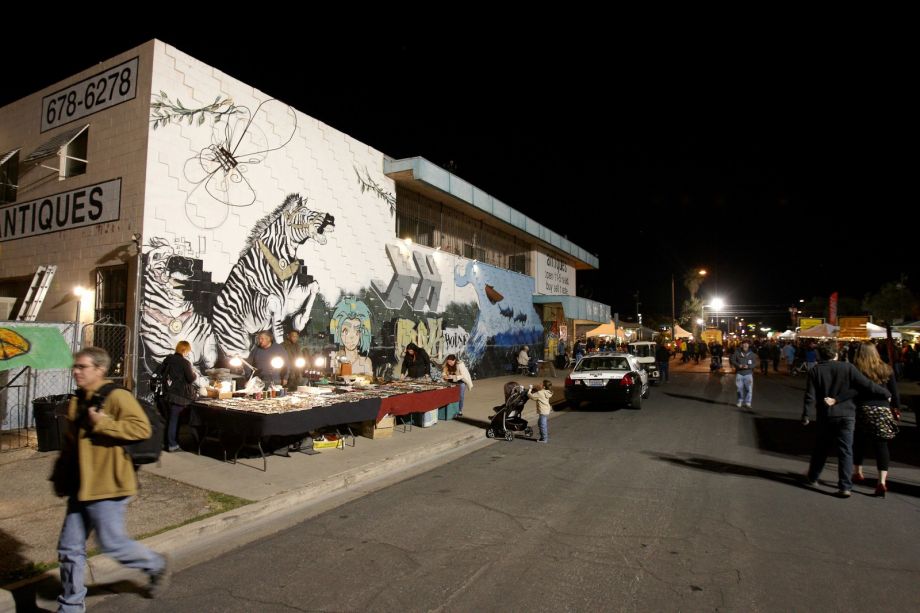
Artists and entrepreneurs have brought new energy to long-neglected Fremont Street East.
Las Vegas can feel like a city without a history, an almost lunar settlement in a barren, rocky desert, where civic landmarks are regularly imploded to make way for newer, bigger, shinier replacements. But downtown Las Vegas has a hundred-year pedigree — albeit of being purposefully unpedigreed. The railroad first connected Las Vegas to Los Angeles in 1905, and the Mojave outpost immediately embarked on its development strategy of providing the things that proper, prosperous Californians deemed beneath their collective dignity: Gambling dens and quickie divorces. In 1906, the Golden Gate, Las Vegas’s oldest casino still in operation, opened up at the corner of Main and Fremont streets next to the (now defunct) train station. A government center of courthouses and a city hall sprung up on the surrounding streets. Soon a string of casinos filled in Fremont Street down the numbered blocks stretching out from the train depot, culminating in the El Cortez on 6th Street, which opened in 1941. As the unchallenged downtown of a growing city, retail followed, including major department stores like Sears Roebuck.
But significant property taxes, limits on building footprints in the dense downtown and the rise of the automobile soon had casino developers buying large plots a few miles away along Las Vegas Boulevard in unincorporated Clark County. The Flamingo, opened on the Boulevard in 1946 under the exacting eye of dashing organized crime figure Benjamin “Bugsy” Siegel, set a new standard for glitz and began the inexorable shift in the center of gambling gravity from the Fremont Street area downtown to the stretch of pavement now known worldwide simply as “the Strip.” As the decades passed and the Strip’s casinos became ever more lavish, the old gambling halls on Fremont Street began catering to an older, less affluent crowd, serving up bargain prime rib specials and offering vast seas of penny slots. Since the Strip stands beyond the limits of the City of Las Vegas, schemes to reclaim downtown’s lost glory have been on the agenda in city hall for decades.
Downtown’s first strategy for regaining its cachet was to beat the suburbs at their own game. The city adopted a suburban-style zoning code for downtown that required new businesses to provide plenty of parking on the suburban strip mall model. Few strip malls opened up. Instead, the streets beyond the string of casinos filled up with motels, many renting rooms by the week, some as de facto homeless shelters. The courthouses never went anywhere, nor did their attendant businesses — law offices, bail-bondsmen and spur-of-the-moment wedding chapels — but the anticipated downtown renaissance never followed. With its suburban zoning code, the City had essentially outlawed city life in Las Vegas.
In 1994, in its next stab at downtown rehabilitation, the city got the various downtown casino owners to collaborate on a single attraction it hoped could compete with the glitz of the Strip. Dubbed the Fremont Street Experience, the casinos’ stretch of Fremont Street was turned into a pedestrian-only walkway and covered by a canopy that, in its latest technological update, boasts the world’s largest LED screen. Each night, the casinos turn off their flashing lights en masse and a multimedia classic rock tribute show plays itself out above as slack-jawed tourists gawk upwards. The current show, featuring a jingoistic Stars-and-Stripes montage set to “We are the Champions” by the (British) rock group Queen, unfailingly draws a crowd. But it is no competition for the Strip with Paris, Venice and New York on a single street.
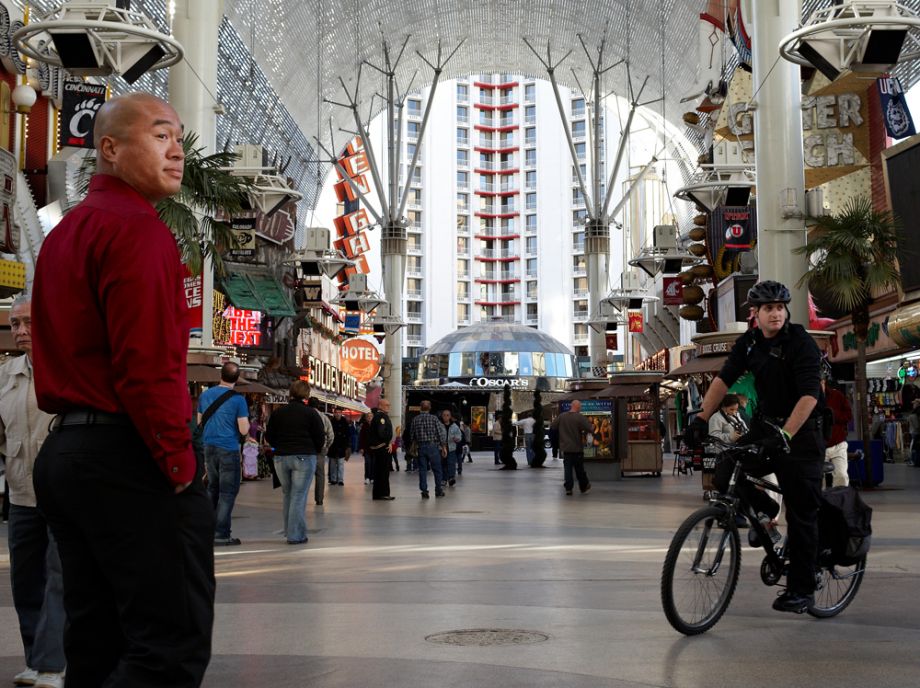
Casinos and other businesses vie for attention at the Fremont Street Experience, a circa-1994 attempt to revive downtown.
In 1999, Las Vegas voters elected Oscar Goodman, a flamboyant Philadelphia-born attorney who had built his career defending organized crime figures, as their new mayor. (Goodman, who left office in 2011 on account of term limits — voters chose his wife, Carolyn, as his replacement — now serves the local tourism board as the official “ambassador of Las Vegas,” essentially the region’s mascot.) When first elected, Goodman admits, he was an urban planning novice — “I didn’t know infill from the outfield,” he quips, sporting a dark suit, shiny gold tie and flamingo-pink, cursive “Las Vegas” lapel pin — but he knew something had to be done about a downtown that was “beginning to look like a war zone.” He requested a tutorial from the president of The Rouse Company, a real estate firm known for building “festival marketplaces” — glorified downtown malls — in Manhattan (South Street Seaport), Boston (Faneuil Hall Marketplace) and Baltimore (Harborplace), and popularizing their spread to other cities looking to inject life into moribund downtown neighborhoods.
Following the crash course in urban revitalization, Goodman concluded the city needed to control a large plot of land. Purchasing a 61-acre brownfield just over the railroad tracks from downtown, Goodman began a series of megaprojects. Today the area is an archipelago of iconic buildings — a Rouse-ian outlet mall complete with pedestrian streets packed during business hours and locked shut at night, a performing arts center done up in Art Deco Revival style, and the Frank Gehry-designed Lou Ruvo Center for Brain Health, a swirl of titanium curlicues — all set within a vast sea of parking. Las Vegas got its festival marketplace. What it didn’t get was a real downtown. Walking through the area, all icons and emptiness, feels like living in a Giorgio de Chirico painting.
Downtown redevelopment proceeded by other means when the Las Vegas boom went bust on Goodman’s watch, and the mayor launched a series of stimulus projects to provide jobs for unemployed construction workers. The most audacious of the undertakings was building a new LEED-certified city hall. Only in Las Vegas would the existing city hall, a beige modernist 11-story structure topped by a telescopic tower that opened in 1973 and was renovated during Goodman’s first term, be considered obsolete. Goodman also secured funding from various public and private sources to put Las Vegans back to work turning a shuttered downtown federal building into the National Museum of Organized Crime and Law Enforcement, a.k.a. The Mob Museum. (Goodman personally donated a slew of personal mafia-related memorabilia to the permanent collection, including his “gelt bag,” a large briefcase in which his clients, wary of having their checking accounts frozen by the feds, paid for his legal services in cash.)
For all these top-down mega-projects, Goodman also encouraged a finer- grained, bottom-up urban revival. Rezoning the stretch of Fremont Street east of the casinos allowed for an urban renaissance of sorts, albeit on a single block. The city widened the sidewalks and encouraged non-casino bars to open by waiving their liquor license fees, which in downtown Vegas can cost up to $75,000. Soon the 600 block of Fremont Street became a kind of paint-by-numbers hip downtown with a neighborhood pub (The Griffin), a coffee house with gallery spaces above (The Beat), and an upscale boîte (Downtown Cocktail Room) that bills itself as “3,000 square feet of warm bohemian-chic décor with the sexiest libations and staff.” The generic names testify to the city’s erstwhile urban underdevelopment.
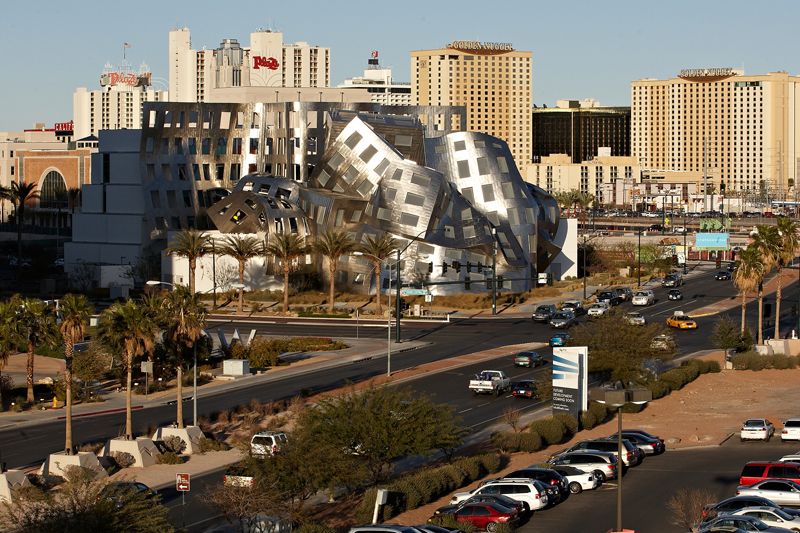
Downtown Vegas struggles with the same problem that ails many downtowns: Too many cars and too few people on the streets.
Today, downtown Las Vegas has everything a city could want: 24/7 activity on account of the casinos, tens of thousands of downtown jobs (mostly in government and hospitality), a sparkling new local history museum, a falling crime rate, a smattering of trendy bars, cafes and art galleries, even a Frank Gehry building. But what it doesn’t have is critical mass. While the 600 block of Fremont Street is packed with businesses, the 700 block has little besides a low-rent motel, a boarded-up casino dominates the 800 block, while the 900 block offers up a chain-link-fence-encircled cement lot punctuated by palm trees. The 1000 block plays host to an incongruous downtown trailer park that, according to reception clerk Jason Nuckolls, rents spaces for $15 a night with full hook-up.
The best view of this block-by-block decline belongs to Tony Hsieh, who lives on the top floor of The Ogden, the only upscale apartment building in the heart of downtown. Hsieh’s 25th-floor view offers a real-life cadastral map of a downtown that appears to be more parking lots and sandlots than actual urban fabric. On account of the vacant lot across the street from The Ogden, Hsieh enjoys unimpeded views of the former city hall, the building that Zappos will move into in 2013.
“I’m not the one who wants a doggie daycare. The Post-it notes are not my ideas, they’re from people who come through.”
“I don’t follow politics,” Hsieh confessed, “so I didn’t even know about the city hall move.” But when he found out the old structure was available, he jumped at the chance to move his company there. Wary of Amazon’s sluggish bureaucracy in Seattle, Zappos opted to rent rather than own its new headquarters. With Zappos committed to a 15-year lease, the private real estate developer RGG bought the building from the city for $18 million and pledged an additional $40 million for renovations.
With Zappos committed to moving to the old city hall, Hsieh, flush with hundreds of millions in the wake of the sale to Amazon, launched his Downtown Project, devoting $200 million to purchase and develop as much of the surrounding downtown as owners were willing to sell him. Though still in its infancy, more plans than progress, Downtown Project is arguably the most ambitious one-man urban renewal effort since the creation of Rockefeller Center.
Patrick Olsen, a mop-topped rock-climbing enthusiast and recent UNLV grad, is one of a dozen or so staffers implementing Hsieh’s vision. Olsen, like most of Downtown Project’s staff, is technically an employee of Zappos, but splits his time between the two offices. On the top floor of The Ogden, Olsen laid out the Project’s vision for the neighborhood, imperiously pointing down upon the affected areas.
Downtown Project brims with a confidence that if you build it — bars, restaurants, parks, good schools and a grocery store — they will come. Zappos employees, of course, will come regardless when their office relocates, but Hsieh is trying to lure other tech companies downtown with $50 million pledged to venture capital for local startups. The hope is that, as critical mass builds, the neighborhood will take on a momentum of its own, with refugees from the suburban, car-centric, solipsistic Las Vegas lifestyle flocking to the old center.
Part of engineering that critical mass is weening Hsieh’s own employees off their Henderson-bred dependence on company-provided services and pushing them to recirculate their paychecks through local businesses. The coffeeshop in the new headquarters, for instance, is planned to be much more modest than the cafeteria in Henderson, which offers free beverages and snacks 24/7 and hot meals for just three dollars. The hope is that in addition to supporting neighborhood coffeeshops, the push off campus will foster unplanned interactions, the kind of random encounters that were typical in the company’s old neighborhood in San Francisco. Zappos executives are confident that, as employees bump into each other on the sidewalks and in neighborhood establishments, they will figure out even better ways to sell shoes on the Internet.
This would seem an uphill battle against the car-and-sprawl-oriented regional culture. A skybridge links the massive parking lot across the street directly to the city hall building, making it possible to drive in from the suburbs, work a full day, and then go home at night without ever touching the sidewalks of downtown Las Vegas. This is how most of the about 48,000 people who already work downtown experience (or, more accurately, don’t experience) the neighborhood. Even for the roughly 10,000 people who already live downtown, simply going to the supermarket requires motorized transportation. But the hope is that, lured with amenities like bike-sharing and new housing options, more and more downtown employees will live, work and play in the neighborhood.
Specifically which amenities downtown will offer is still in the brainstorming phase. Visitors to the top floor of The Ogden — a vast amorphous space that is both a Downtown Project office and Tony Hsieh’s apartment — are asked to add to its Post-it note wall of suggestions for the neighborhood (“wine bar,” “pre-K,” “doggie daycare,” “community newspaper,” “yoga”). Olsen explains that Downtown Project plans to find passionate entrepreneurs eager to open just such businesses and help place them in a Hsieh-owned parcel of real estate. Hoping to adopt the best practices from other cities, plans are being hatched to offer small businesses a kind of audition in a converted shipping container stationed in a vacant lot, an idea already gaining popularity in the Bay Area. Startups that succeed would then be offered more conventional space in a building.
When asked about his personal role, Hsieh emphasizes its modesty. “I’m not the one who wants a doggie daycare. The Post-it notes are not my ideas, they’re from people who come through,” he says. “I have veto power and that’s it.”
Olsen is less judicious. “We don’t have enough money to build a city,” he says, “[but] we can curate and control” a section of it. Rather than the Googleplex model of a self-sufficient suburban space station, Downtown Project aims to create something akin to New York University where, Olsen says, “you’re not entirely sure whether you’re on or off campus.” Except Olsen’s not just talking about the Zappos headquarters — he’s talking about the whole of downtown Las Vegas owned by a single man.
Hsieh insists this kind of centralized power and planning is the only way such a downtown can be built. To meet its vision for a vibrant urban core, Downtown Project has set a density goal of 100 people per acre. As Hsieh explains, only by owning and developing real estate himself can this level of density be assured. Left to its own devices, the market builds sprawl, rendering 100-people-per-acre a pipedream. Its best-case scenario would be a smattering of urban infill townhouses downtown, but even that seems unlikely given the bargain-basement prices for existing homes all over the Valley, many of which can now be bought for less than the cost of construction.
Set for life and content to drive his Mazda, Hsieh can afford to think long-term and balance what he calls “return on community” with “return on investment.”
“We won’t get density from ROI,” he says. Though Downtown Project is a for-profit developer, it plans to balance profit-making ventures like tech company office space with money-losers like parks and co-working spaces for self-employed artists. Hsieh is a savvy enough businessman to know that unbridled markets maximize profits, not community: It gives us Amazon and kills the neighborhood bookstore. And he is a savvy enough businessman to know that over the long-term, a neighborhood with parks and arts spaces will be worth more than a downtown without them.
“What is meant to look like the hottest party you’ve ever stumbled upon is actually a carefully constructed fraud.”
There is precedent for Hsieh’s attempt at one-man neighborhood transformation. The now-posh section of Brooklyn, New York, alongside the East River between the Brooklyn and Manhattan Bridges, was the brainchild of real estate developer David Walentas, who bought up the abandoned warehouses and rotting docks and rechristened the area DUMBO. Not unlike Hsieh, Walentas saw the next Soho in a graffiti-covered warren of vacant commercial buildings. He bought them up at fire-sale prices with a plan to develop a new neighborhood that would be marketed first to artists and then to professionals, lured by luxury lofts in a bohemian-chic setting. A few miles from DUMBO, the Red Hook section of Brooklyn was also reinvented largely by one man, a police-detective-turned-real-estate-baron named Greg O’Connell.
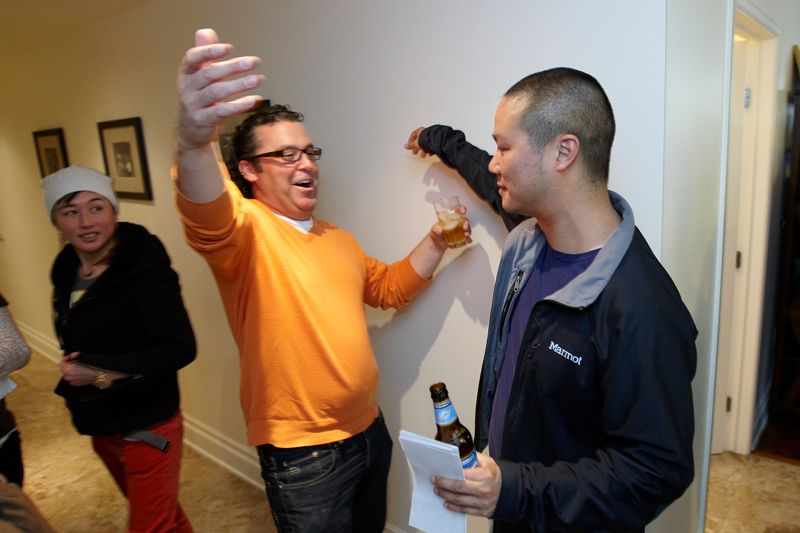
Hsieh, right, greets a friend at a Zappos-sponsored bash in the company’s downtown apartment. The house party was part of First Friday festivities in March.
What Hsieh shares with these developers is a belief in the Richard Florida school of urban revitalization: That if you bring in the so-called “creative class,” everyone else, and their money, will soon follow. And that rather than leave it to urban pioneer artists to discover the next cool neighborhood, savvy real estate developers can engineer the process themselves for their own profit. But logistics alone suggest luring educated professionals from San Francisco to Las Vegas will be tougher than luring them from Manhattan to Brooklyn. Only time will tell whether Hsieh is naïve or prescient, but established real estate developers who dismiss his lack of experience in their field ought to think twice. Real estate finance is the one aspect of his ambitious project that Hsieh speaks about with authority, rattling off the economic history of The Ogden, from boom-time white elephant condominium project to post-bust rental apartments, with a Rain-Man-like string of off-the-cuff per-square-foot cost estimates.
Putting Hsieh’s vision into practice will depend on both competence and good luck. As Olsen laid out the boundaries of the Downtown Project — about one square mile around the heart of downtown — and explained that it was attempting to buy every parcel of land in the catchment area, Hsieh sat unobtrusively at a desk in his usual Zappos T-shirt and jeans, looking over an aerial map of the neighborhood. The map was color-coded by ownership status, with white signifying “hold out.”
As the white blotches marring Hsieh’s map made clear, not every property owner is eager to sell. And just figuring out who owns what is a Herculean task. The same real estate crash that makes it possible to buy all of downtown Las Vegas for a song has created the bureaucratic nightmare of looking up — and likely paying — the overdue utility bills left unpaid by absentee landlords. Downtown Project is currently engaged in 140 different negotiations to buy pieces of the neighborhood but has thus far successfully closed on only two parcels. One is the low-rent motel on the 700 block of Fremont Street. Its marquee offers rooms for $29.99, but when I walked into the reception area, a security guard sent me away with a brusque, “I’m sorry. This business has been closed.” According to Olsen, Downtown Project is mulling a $10 million investment to transform it into a boutique hotel.
Though the Downtown Project is keen on bringing in certain neighborhood amenities that will benefit virtually everyone — like a full-service supermarket — it does suffer from a bit of a boutique hotel problem. Though remarkably open to visitors, Downtown Project is ultimately a private office staffed by unelected officers answering not to their neighborhood but to their boss. Many of the community’s longest-term, most marginalized residents seem unlikely to be invited up to add to the Post-it note wall, especially considering Olsen’s fondness for the term “riff-raff.” And many of the things the community needs even more than a wine bar — a homeless shelter, a compulsive gambling help center, an income tax to fund public services — are unlikely to end up as suggestions. While skeptics suspect Hsieh is just interested in growing his fortune, Hsieh’s community-oriented selflessness seems genuine. The more salient worry is cluelessness. Hsieh’s tremendous wealth hasn’t made him greedy, just out of touch with the tribulations of his downtown neighbors, who house themselves week-to-week.
As Terrie D’Antonio, CEO of HELP of Southern Nevada, a nonprofit that helps connect the homeless people to jobs and housing, explained, many elderly downtown residents live in area motels for the first two weeks of the month, until their Social Security checks are exhausted. Then they move into tent encampments for the duration of the month. If Downtown Project’s real estate development reduces the number of rooms in “the weeklies,” as D’Antonio calls them, “they would lose that option.” Drawing on her experience with previous demolitions of low-end rental housing in Las Vegas, eviction would push some residents to seek the services they needed all along. But for others, particularly undocumented immigrants who do not qualify for federal housing assistance, it would be catastrophic. When I asked D’Antonio if Downtown Project had contacted HELP, she replied, “No, they have not.”
“But we would absolutely love to work with them,” she hastened to add.
Just beyond Hsieh’s target area, a real-estate developer is putting the final touches on a kind of mini-Downtown Project. Vegas-born, Ivy League-educated casino entrepreneur Seth Schorr and his investors, who control the defunct Lady Luck casino on the stretch of 3rd Street just off Fremont, have ambitious plans for rehabilitation of the hotel and its surrounding real estate. As construction workers gut and renovate the property, to be reopened as the Downtown Grand next year, Schorr is brainstorming what to do with the street, which he’s branded “Downtown 3rd.” Through a zoning quirk, the road itself private property zoned for gaming, so Schorr is in the process of patenting a new game he calls “Street Dice” that replicates the illicit numbers games that sprang up in Depression-era Chicago alleyways.
In the adjacent retail spaces, Schorr aims to curate an eclectic assortment of bars, shops and restaurants to give the street the look and feel of a real city. One establishment, called Mob Bar — all leather banquettes, polished dark-wood and bow-tied bartenders — is already open for business. Down the street, Schorr is bringing in a branch of Pizza Rock, “a concept out of Sacramento,” he explains, that involves tatted-up pizza-slingers who take seemingly impromptu work-breaks to croon for the crowd.
“It sounds cheesy—no pun intended — but it’s very sexy, very urban,” Schorr insists. With his blue blazer and neatly-cropped hair, Schorr cuts the figure of an honest and competent businessman—but he hardly seems like Sin City’s leading authority on sexy. “The Strip creates an amazing fantasy,” Schorr says, but downtown should be “an alternative experience that shares some aspects of fantasy but with some authenticity.” In great cities, “one of the cool things is seeing real life.”
It is a very Vegas take on real life. In the nightclubs and party pools of the Strip, promoters work tirelessly to create an even-better-than-the-real-thing hyper-reality. The crowds, which look like a natural mix of whomever showed up, are meticulously curated. People walking through casinos who look attractive and/or rich are given passes to skip the cover charge. Busloads of bronzed beauties from Southern California, many of them surgically-enhanced, are shipped in each weekend, given a free trip to Vegas in exchange for partying when and where they’re told. What is meant to look like the hottest party you’ve ever stumbled upon is actually a carefully constructed fraud.
Hsieh’s Downtown Project seems fated to simply be a larger version of Schorr’s Downtown 3rd. For all Hsieh’s insistence that “we’re anti-master planning, we don’t want to be the gatekeepers…I don’t want a company town,” a real city is not made to look unplanned; with its mix of public, private and non-profit owners, it really is unplanned.
Already it is virtually impossible to find anyone downtown to say a bad thing about Hsieh, since virtually everyone is already on the payroll. Even Steven Jacobs — a 21-year-old graffiti artist who rails against the gated community homeowners whose complaints led to the removal of his latest mural — has nothing but praise for the Downtown Project. As we spoke at First Friday, I noticed two plain wooden benches by his sales booth with “DowntownProject.com” carved into them. They were donated by Hsieh’s investment arm, he said, in exchange for a pledge to decorate them.
What would happen, I wondered, if Jacobs decorated his bench in a way critical of Hsieh or Zappos or the Downtown Project? After all, Rockefeller Center, though indisputably a successful real estate venture, was also the scene of America’s greatest crime against art. Nelson Rockefeller hired Mexican muralist Diego Rivera to paint the lobby at 30 Rock only to fire Rivera and destroy his mural when he learned it contained themes critical of oligarchy.
Hsieh insists, “I have veto power and that’s it.” That’s it, indeed.
Our features are made possible with generous support from The Ford Foundation.

Daniel Brook has published on urbanization in India in The New York Times Magazine, Slate, and The Baffler and in his book, A History of Future Cities, which is now out in paperback from W. W. Norton.
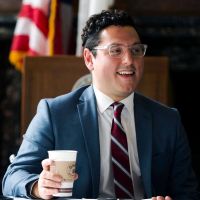
Aaron Mayes remembers riding in a car down Fremont Street as a child. “I have faint memories of girls dancing in second story windows,” he says. “To a five- or six-year old, Fremont Street was bright, beautiful and a bit scary.” That drive is no longer possible, as the street has been turned into a pedestrian mall and covered with a multimedia canopy, just one of many changes downtown Las Vegas has undergone during Mayes’ lifetime. See more of his work here: aaronmayes.com.

20th Anniversary Solutions of the Year magazine